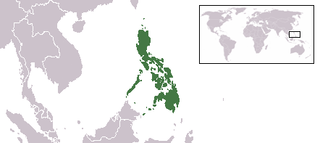| Greater Manila Area | |||||
| Former Chartered City of the Philippines | |||||
| |||||
| History | |||||
| • | Established | 1941 | |||
| • | Disestablished | 1940s | |||
The Greater Manila Area (GMA) [1] or the City of Greater Manila is a former chartered city [2] which existed during the World War II era. It was governed by the Philippine Commonwealth and was dissolved by the Japanese occupation forces.

World War II, also known as the Second World War, was a global war that lasted from 1939 to 1945. The vast majority of the world's countries—including all the great powers—eventually formed two opposing military alliances: the Allies and the Axis. A state of total war emerged, directly involving more than 100 million people from over 30 countries. The major participants threw their entire economic, industrial, and scientific capabilities behind the war effort, blurring the distinction between civilian and military resources. World War II was the deadliest conflict in human history, marked by 50 to 85 million fatalities, most of whom were civilians in the Soviet Union and China. It included massacres, the genocide of the Holocaust, strategic bombing, premeditated death from starvation and disease, and the only use of nuclear weapons in war.

The Japanese occupation of the Philippines occurred between 1942 and 1945, when Imperial Japan occupied the Commonwealth of the Philippines during World War II.
The Greater Manila Area was formed as an emergency measure by President Manuel L. Quezon as a merger of the cities of Manila and Quezon City with the towns of Caloocan, Las Piñas, Malabon, Mariquina, Muntinlupa, Navotas, San Pedro de Macati, San Felipe Neri, Parañaque, Pasig, San Juan del Monte, and the Taguig-Pateros area. Jorge Vargas was appointed as Mayor of Greater Manila. [3]

Manuel Luís Quezon y Molina was a Filipino statesman, soldier and politician who served as president of the Commonwealth of the Philippines from 1935 to 1944. He was the first Filipino to head a government of the entire Philippines, and is considered to have been the second president of the Philippines, after Emilio Aguinaldo (1899–1901).

Manila, officially the City of Manila, is the capital of the Philippines. It is the most densely populated city proper in the world. It was the first chartered city by virtue of the Philippine Commission Act 183 on July 31, 1901 and gained autonomy with the passage of Republic Act No. 409 or the "Revised Charter of the City of Manila" on June 18, 1949. Manila, alongside Mexico and Madrid are considered the world's original set of Global Cities due to Manila's commercial networks being the first to traverse the Pacific Ocean, thus connecting Spanish Asia with the Spanish Americas, marking the first time in world history when an uninterrupted chain of trade routes circled the planet. Manila has been damaged by and rebuilt from wars more times than the famed city of Troy and it is also the second most natural disaster afflicted capital city in the world next to Tokyo yet it is simultaneously among the most populous and most wealthy cities in Southeast Asia.

Quezon City is the most populous city in the Philippines. It was founded by and named after Manuel L. Quezon, the 2nd President of the Philippines, to eventually replace Manila as the national capital. The city was proclaimed as such in 1948. However, since practically all government buildings are still in Manila, many functions of national government remained there. Quezon City held the status as the official capital until 1976 when a presidential decree was issued to designate Manila as the capital and Metro Manila as the seat of government.
Mayors of the towns and cities that comprised Greater Manila became vice mayors of their respective localities and was under the Mayor of Greater Manila. [3]
The Japanese dissolved Greater Manila, and the area which formed the city was governed by the Philippine Executive Commission, which also administrate other Japanese occupied territories in the Philippines during the war. [3]

The Philippine Executive Commission was a provisional government set up to govern the Philippine archipelago during World War II. It was established with sanction from the occupying Imperial Japanese forces as an interim governing body prior to the establishment of the Japanese-sponsored and nominally independent, Second Philippine Republic.












